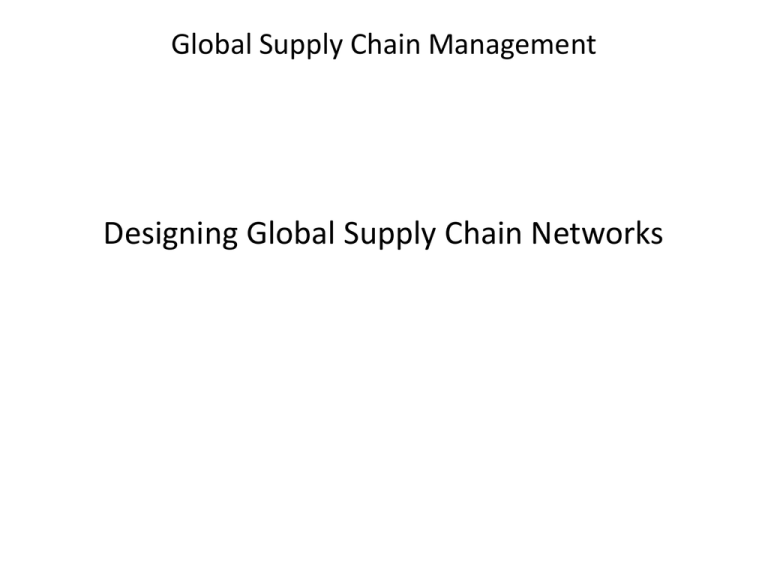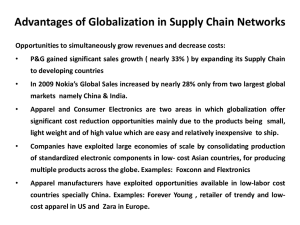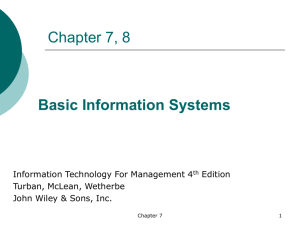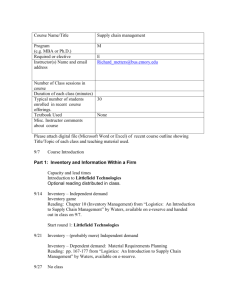Risk Factors Percentage of Supply Chains Impacted
advertisement

Global Supply Chain Management Designing Global Supply Chain Networks Global Supply Chain provides advantages due to Flexibility • Off-Shoring & Out Sourcing provides Three broad categories of flexibility: New product flexibility Ability to introduce new products into the new markets Mix flexibility Ability to produce a variety of products Volume flexibility Ability to operate profitably at different levels of output Globalization of Supply Chain Networks: Opportunities & Challenges OPPORTUNITIES: • Growth in Revenues with or without Cost Reduction • Capacity Aggregation • Inventory Aggregation • Transportation Aggregation • Warehousing Aggregation • Procurement Aggregation • Information Aggregation • Receivable Aggregation • Relationship Aggregation Risks involved in Globalization of Supply Chain Networks Risk Factors Percentage of Supply Chains Impacted Natural disasters 35 Shortage of skilled resources 24 Geopolitical uncertainty 20 Terrorist infiltration of cargo 13 Volatility of fuel prices 37 Currency fluctuation 29 Port operations/custom delays 23 Customer/consumer preference shifts 23 Performance of supply chain partners 38 Logistics capacity/complexity 33 Forecasting/planning accuracy 30 Supplier planning/communication issues 27 Inflexible supply chain technology 21 The Offshoring Decision: Total Cost • Quantify the benefits of offshore production on Total Cost basis • A global supply chain with offshoring increases the length and duration of information, product, and cash flows • The complexity and cost of managing the supply chain can be significantly higher than anticipated • Quantify factors and track them over time • Big challenges with off shoring is increased risk and its potential impact on cost The Offshoring Decision: Total Cost • Key elements of total cost Supplier price Terms Delivery costs Inventory and warehousing Cost of quality Customer duties, value added-taxes, local tax incentives Cost of risk, procurement staff, broker fees, infrastructure, and tooling and mold costs Exchange rate trends and their impact on cost The Offshoring Decision: Total Cost Performance Dimension Activity Impacting Performance Impact of Offshoring Order communication Order placement More difficult communication Supply chain visibility Scheduling and expediting Poorer visibility Raw material costs Sourcing of raw material Could go either way depending on raw material sourcing Unit cost Production, quality (production and transportation) Labor/fixed costs decrease; quality may suffer Freight costs Transportation modes and quantity Higher freight costs Taxes and tariffs Border crossing Could go either way Supply lead time Order communication, supplier production scheduling, production time, customs, transportation, receiving Lead time increase results in poorer forecasts and higher inventories Table 6-2 The Offshoring Decision: Total Cost Performance Dimension Activity Impacting Performance Impact of Offshoring On-time delivery/lead time uncertainty Production, quality, customs, transportation, receiving Poorer on-time delivery and increased uncertainty resulting in higher inventory and lower product availability Minimum order quantity Production, transportation Larger minimum quantities increase inventory Product returns Quality Increased returns likely Inventories Lead times, inventory in transit and production Increase Working capital Inventories and financial reconciliation Increase Hidden costs Order communication, invoicing errors, managing exchange rate risk Higher hidden costs Stock-outs Ordering, production, transportation with poorer visibility Increase Table 6-2 The Offshoring Decision: Total Cost • A global supply chain with offshoring increases the length and duration of information, product, and cash flows • The complexity and cost of managing the supply chain can be significantly higher than anticipated • Quantify factors and track them over time • Big challenges with off shoring is increased risk and its potential impact on cost Risk Management in Global Supply Chains • Risks include supply disruption, supply delays, demand fluctuations, price fluctuations, and exchange-rate fluctuations • Critical for global supply chains to be aware of the relevant risk factors and build in suitable mitigation strategies Risk Management in Global Supply Chains Category Risk Drivers Disruptions Natural disaster, war, terrorism Labor disputes Supplier bankruptcy Delays High capacity utilization at supply source Inflexibility of supply source Poor quality or yield at supply source Systems risk Information infrastructure breakdown System integration or extent of systems being networked Forecast risk Inaccurate forecasts due to long lead times, seasonality, product variety, short life cycles, small customer base Information distortion Table 6-3 Risk Management in Global Supply Chains Category Risk Drivers Intellectual property risk Vertical integration of supply chain Global outsourcing and markets Procurement risk Exchange-rate risk Price of inputs Fraction purchased from a single source Industry-wide capacity utilization Receivables risk Number of customers Financial strength of customers Inventory risk Rate of product obsolescence Inventory holding cost Product value Demand and supply uncertainty Capacity risk Cost of capacity Capacity flexibility Table 6-3 Risk Management in Global Supply Chains • Good network design can play a significant role in mitigating supply chain risk • Every mitigation strategy comes at a price and may increase other risks • Global supply chains should generally use a combination of rigorously evaluated mitigation strategies along with financial strategies to hedge uncovered risks Risk Management in Global Supply Chains Risk Mitigation Strategy Tailored Strategies Increase capacity Focus on low-cost, decentralized capacity for predictable demand. Build centralized capacity for unpredictable demand. Increase decentralization as cost of capacity drops. Get redundant suppliers More redundant supply for high-volume products, less redundancy for low-volume products. Centralize redundancy for low-volume products in a few flexible suppliers. Increase responsiveness Favor cost over responsiveness for commodity products. Favor responsiveness over cost for short–life cycle products. Table 6-4 Risk Management in Global Supply Chains Risk Mitigation Strategy Tailored Strategies Increase inventory Decentralize inventory of predictable, lower value products. Centralize inventory of less predictable, higher value products. Increase flexibility Favor cost over flexibility for predictable, high-volume products. Favor flexibility for unpredictable, low-volume products. Centralize flexibility in a few locations if it is expensive. Pool or aggregate demand Increase aggregation as unpredictability grows. Increase source capability Prefer capability over cost for high-value, high-risk products. Favor cost over capability for low-value commodity products. Centralize high capability in flexible source if possible. Table 6-4 Flexibility, Chaining, and Containment Figure 6-1 Flexibility, Chaining, and Containment • As flexibility is increased, the marginal benefit derived from the increased flexibility decreases With demand uncertainty, longer chains pool available capacity Long chains may have higher fixed cost than multiple smaller chains Coordination more difficult across with a single long chain • Flexibility and chaining are effective when dealing with demand fluctuation but less effective when dealing with supply disruption Using Decision Trees • Many different decisions Should the firm sign a long-term contract for warehousing space or get space from the spot market as needed? What should the firm’s mix of long-term and spot market be in the portfolio of transportation capacity? How much capacity should various facilities have? What fraction of this capacity should be flexible? Using Decision Trees • During network design, managers need a methodology that allows them to estimate the uncertainty in demand and price forecast and incorporate this in the decision-making process • Most important for network design decisions because they are hard to change in the short term Basics of Decision Tree Analysis • A decision tree is a graphic device used to evaluate decisions under uncertainty Identify the number and duration of time periods that will be considered Identify factors that will affect the value of the decision and are likely to fluctuate over the time periods Evaluate decision using a decision tree





